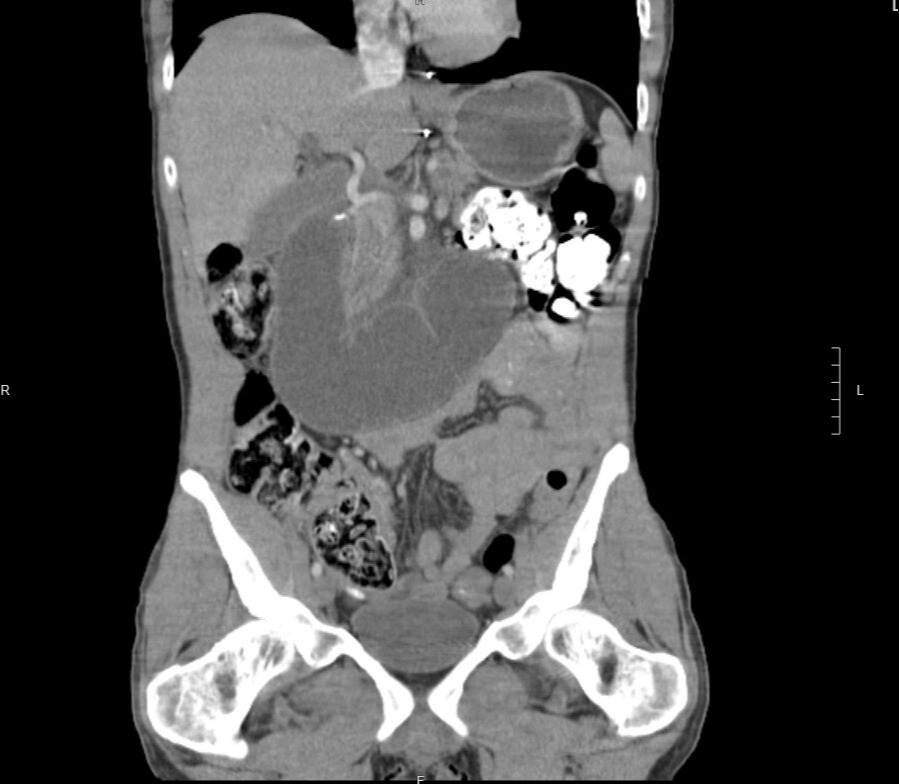Back


Poster Session A - Sunday Afternoon
Category: Biliary/Pancreas
A0039 - Pancreaticobiliary Limb Stenosis in Billroth II Reconstruction as a Cause for Recurrent Acute Pancreatitis
Sunday, October 23, 2022
5:00 PM – 7:00 PM ET
Location: Crown Ballroom

Has Audio
- ID
Ivana Deyl, MD
University of Kentucky
Lexington, KY
Presenting Author(s)
Ivana Deyl, MD1, Cyrus Khalily, 1, Courtney Perry, DO1, Bahaaeldeen Ismail, MD1, Ahmed Al-Chalabi, MD2
1University of Kentucky, Lexington, KY; 2University of Kentucky College of Medcine, Lexington, KY
Introduction: Afferent loop syndrome (ALS) has been described in patients with altered gastric anatomy, especially after gastrojejunostomy with Billroth II or Roux-en-Y reconstruction. It has been suggested that a distal obstruction causes increased intraluminal pressure within the afferent small bowel limb leading to accumulation of bile, pancreatic fluids, and small intestinal secretions. We present a case of afferent loop syndrome presenting as acute pancreatitis.
Case Description/Methods: A 38-year-old male with a history of pre and post pyloric strictures status post Billroth II reconstruction who was admitted to our hospital with abdominal pain, nausea and vomiting for two days. He was found to have a lipase of 2660 U/l. CT scan of the abdomen showed a dilated duodenal C-loop and changes consistent with acute pancreatitis. He initially underwent an esophagogastroduodenoscopy (EGD) which revealed Billroth II anatomy with surgical staples at the anastomosis, surrounding ulceration and friable mucosa. The entrance to the afferent small bowl limb was severely stenosed and could not be traversed with the ultrathin gastroscope. The patient’s clinical status improved with supportive management and he left against medical advice the following day.
He again presented nine days later with epigastric pain radiating to the back, a lipase of 1927 U/l and CT imaging again showing acute pancreatitis and a dilated duodenal C- loop up to 6.5 cm (Figure 1). He underwent EGD with fluoroscopy; severe stenosis was again found at the afferent jejunal limb orifice. A wire was passed through the stenosed limb, and a Lumen Apposing Metal Stent (LAMS) was deployed through a therapeutic gastroscope. The stenosis was then dilated up to 10 mm through the stent. The patient’s symptoms improved and he was discharged with plans for repeat endoscopy in 6-8 weeks.
Discussion: Pancreaticobiliary limb stenosis at the anastomosis site should be considered as one of the rare causes of recurrent acute pancreatitis, especially in patients with previous gastrectomy Billroth II reconstruction. Prompt identification and treatment of any possible stenosis is essential. The use of LAMS may have the potential advantage of reduced stent migration risk and improved likelihood of stenosis resolution.

Disclosures:
Ivana Deyl, MD1, Cyrus Khalily, 1, Courtney Perry, DO1, Bahaaeldeen Ismail, MD1, Ahmed Al-Chalabi, MD2. A0039 - Pancreaticobiliary Limb Stenosis in Billroth II Reconstruction as a Cause for Recurrent Acute Pancreatitis, ACG 2022 Annual Scientific Meeting Abstracts. Charlotte, NC: American College of Gastroenterology.
1University of Kentucky, Lexington, KY; 2University of Kentucky College of Medcine, Lexington, KY
Introduction: Afferent loop syndrome (ALS) has been described in patients with altered gastric anatomy, especially after gastrojejunostomy with Billroth II or Roux-en-Y reconstruction. It has been suggested that a distal obstruction causes increased intraluminal pressure within the afferent small bowel limb leading to accumulation of bile, pancreatic fluids, and small intestinal secretions. We present a case of afferent loop syndrome presenting as acute pancreatitis.
Case Description/Methods: A 38-year-old male with a history of pre and post pyloric strictures status post Billroth II reconstruction who was admitted to our hospital with abdominal pain, nausea and vomiting for two days. He was found to have a lipase of 2660 U/l. CT scan of the abdomen showed a dilated duodenal C-loop and changes consistent with acute pancreatitis. He initially underwent an esophagogastroduodenoscopy (EGD) which revealed Billroth II anatomy with surgical staples at the anastomosis, surrounding ulceration and friable mucosa. The entrance to the afferent small bowl limb was severely stenosed and could not be traversed with the ultrathin gastroscope. The patient’s clinical status improved with supportive management and he left against medical advice the following day.
He again presented nine days later with epigastric pain radiating to the back, a lipase of 1927 U/l and CT imaging again showing acute pancreatitis and a dilated duodenal C- loop up to 6.5 cm (Figure 1). He underwent EGD with fluoroscopy; severe stenosis was again found at the afferent jejunal limb orifice. A wire was passed through the stenosed limb, and a Lumen Apposing Metal Stent (LAMS) was deployed through a therapeutic gastroscope. The stenosis was then dilated up to 10 mm through the stent. The patient’s symptoms improved and he was discharged with plans for repeat endoscopy in 6-8 weeks.
Discussion: Pancreaticobiliary limb stenosis at the anastomosis site should be considered as one of the rare causes of recurrent acute pancreatitis, especially in patients with previous gastrectomy Billroth II reconstruction. Prompt identification and treatment of any possible stenosis is essential. The use of LAMS may have the potential advantage of reduced stent migration risk and improved likelihood of stenosis resolution.

Figure: Figure 1: Dilated duodenal C- loop
Disclosures:
Ivana Deyl indicated no relevant financial relationships.
Cyrus Khalily indicated no relevant financial relationships.
Courtney Perry indicated no relevant financial relationships.
Bahaaeldeen Ismail indicated no relevant financial relationships.
Ahmed Al-Chalabi indicated no relevant financial relationships.
Ivana Deyl, MD1, Cyrus Khalily, 1, Courtney Perry, DO1, Bahaaeldeen Ismail, MD1, Ahmed Al-Chalabi, MD2. A0039 - Pancreaticobiliary Limb Stenosis in Billroth II Reconstruction as a Cause for Recurrent Acute Pancreatitis, ACG 2022 Annual Scientific Meeting Abstracts. Charlotte, NC: American College of Gastroenterology.

